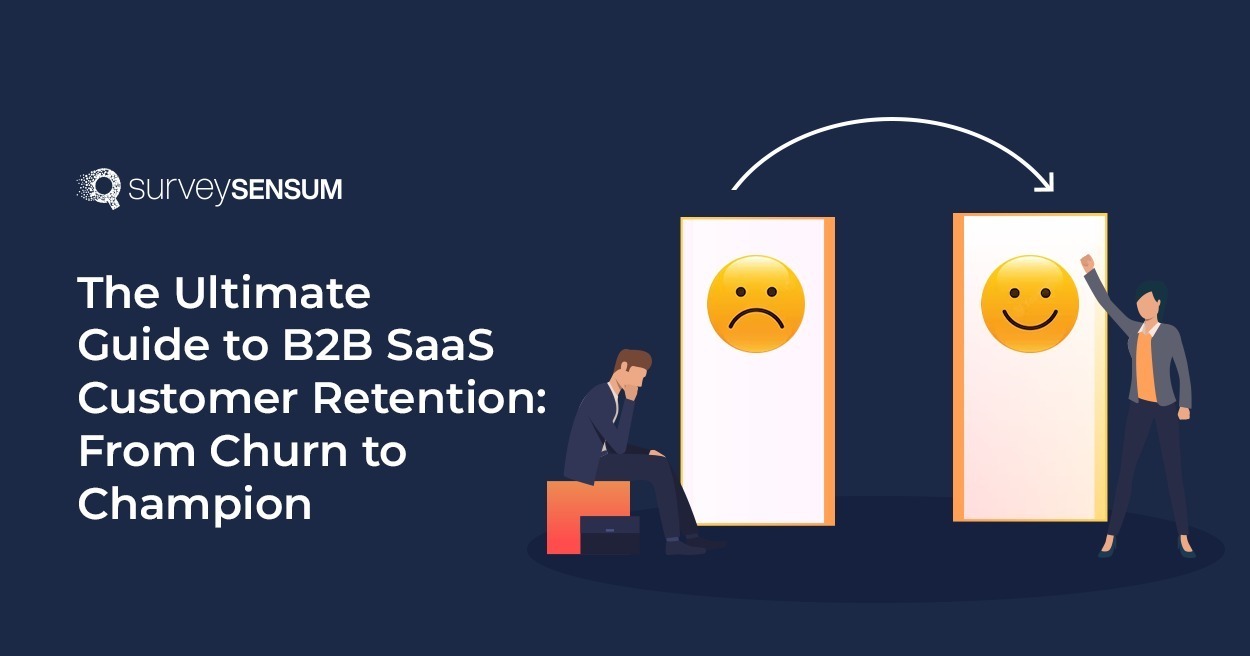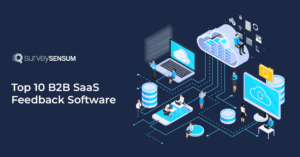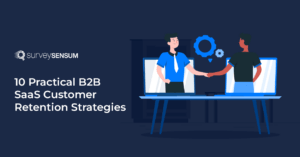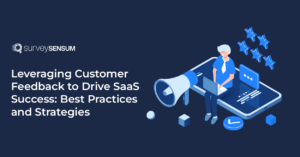
A staggering one-third of B2B SaaS customers buy only monthly plans. That’s a pretty huge number. And that’s why not focusing on customer retention puts a significant portion of customer lifetime value at risk.
No matter, if you’re a new business or well-established, holding on to your existing customers is not just financially viable but absolutely crucial for your brand.
That’s where a SaaS feedback tool comes in handy. It helps to create, distribute, automate, and analyze surveys so you can collect actionable insights and understand what customers really want. But before using any tech, understanding the importance of SaaS customer retention is a top priority.
So, what is SaaS customer retention?
To put simply, customer retention measures your business health.
According to the book Customer Success: How Innovative Companies Are Reducing Churn and Growing Recurring Revenue” by Nick Mehta customer retention refers to the ability of a business to keep its existing clients engaged and satisfied over a certain period, minimizing customer churn and maximizing their lifetime value.
However, only 18% of companies focus on customer retention compared to 44%, which focus on customer acquisition, according to Invesp Consulting. The same study shows that acquiring new customers is 5 times more expensive than retaining your existing customers.
Thus, you must retain your existing customers to maintain long-term relationships and sustain revenue streams. This involves providing excellent service, continuous value, and addressing clients’ evolving needs.
How to Calculate Customer Retention?
Importance of SaaS Customer Retention
How to Fight Customer Churn Efficiently?
- Step 1: Collect Feedback from the Right People
- Step 2: Create the Right Survey and Ask the Right Questions
- Step 3: How to Make Sure your Customers Respond to your Surveys?
- Step 4: Analyze the Gathered Feedback and Close the Feedback Loop
4 Vital Metrics to Measure SaaS Customer Retention
- Net Revenue Rate
- Gross Revenue Retention
- Growth Rate and Referral
- Usage Retention and Loss of Signal
How Customer Retention can help you Bring More business?
- Enabling Advocacy
- Increasing Word of Mouth and Referrals
- Focusing on the key accounts
- Increasing Upselling
- Increasing Cross-selling
Enhance Your SaaS Customer Retention via SurveySensum
After knowing what is customer retention, it’s time to learn its calculation.
How to Calculate Customer Retention?
By using the Customer Retention Rate (CRR) metric. CRR measures the percentage of customers who continue using your SaaS product over a specific period of time. It gives you a clear picture of how well you are retaining your existing customer base. Also, a high retention rate suggests that customers find value in your product and are more likely to stay loyal.
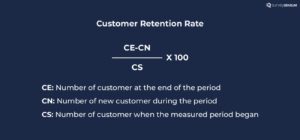
Let’s understand this by taking an example. Say at the beginning of the year (January 1st), your B2B SaaS company had 300 customers. During the year, you acquired 50 new customers. At the end of the year (December 31st), you had 400 customers.
Now use the CRR formula: Customer Retention Rate = ((CE – CN) / CS) * 100
Where:
CE = 400 (customers at the end of the year)
CN = 50 (new customers acquired during the year)
CS = 300 (customers at the start of the year)
CRR = ((400 – 50) / 300) * 100 = (350 / 300) * 100 = 116.67%
So, your B2B SaaS company has a customer retention rate of approximately 116.67% for the year. This indicates that not only did you retain all your existing customers, but you also gained some additional customers, leading to a higher customer count at the end of the year compared to the beginning.
Let’s explore – WHY it is important.
Importance of SaaS Customer Retention
Retaining your existing customers is vital because they
1. Increase Revenue
The longer your customers continue using a SaaS product monthly or yearly, the more money your company makes. But it’s not just about the money your customers pay directly.
Imagine your existing customers on a basic plan approach you with concerns about manually updating records. In response, you can introduce a new workflow and/or automation feature that alleviates their challenges. This enhancement not only addresses their pain points but also encourages them to upgrade their plan – upselling.
→ For instance, Easebuzz increased its upsell by 8%. How? Let’s discuss that later.
Moreover, according to Microsoft America’s Partner blog on 3 prescriptions for subscription success highlights that recurring customers are 5x as likely to repurchase, 5x as likely to forgive, 4x as likely to refer, and 7x as likely to try a new offering.
This link between customer retention and revenue shows how important SaaS customer retention strategies are for a thriving business.
2. Save Customer Acquisition Costs
Demand generation is and always will be a primary source to improve your cash flows. But if you already have loyal customers who are taking care of your Monthly Recurring Revenue (MRR), strategically prioritizing retention emerges as a prudent move.
But here’s the thing: getting new customers isn’t a piece of cake. It takes a bunch of marketing and ads, which can be tough for SaaS models that aren’t all about easy interactions.
And here’s the kicker– getting a new customer might end up costing you a whopping 7 times more than just keeping an old one satisfied. Neil Patel himself says this rising cost means you really need to be smart about how you spend your money.
That’s why keeping your existing customers happy and engaged not only protects your finances but also boosts your profits significantly.
3. Build Loyalty through Customer Satisfaction
You know how good it feels when you buy something and it works perfectly, right? That’s what customer satisfaction is all about.
When customers are happy with your product, they’ll keep using it and won’t look for alternatives. By making their satisfaction a top priority and engaging them consistently, you lay the foundation for a robust customer base.
Consider this compelling stat of McKinsey’s report on Customer Experience, a staggering 87% of satisfied customers are more likely to explore upgrades or additional services. What’s more, they’re significantly less likely to consider canceling.
But it doesn’t end there. The penultimate goal of every company is to increase their brand advocates. So, the bottom line is if your existing SaaS customers are happy with your products and services then they are more likely to recommend your product in their business meetings, to their colleagues, in turn bringing in new customers and generating more revenue.
Now that you know the importance of SaaS customer retention and SaaS customer acquisition, you’ll begin working on it, right? But what will you do to fight customer churn?
How to Fight Customer Churn Efficiently?
To fight customer churn, you’ve to effectively implement the following 4 strategies:
STEP 1: Collect Feedback from the Right People
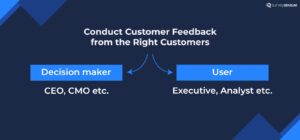
You must collect customer feedback from the right people.
But how to determine who is the right person? There are two types of respondents –
1. Decision-makers
Send surveys to the decision-makers because they’re the ones responsible for making important decisions about whether to renew the product, continue with your services, or explore alternative options. You must build a healthy relationship with them to understand their needs and preferences better.
2. Product Users
Send surveys to the product users because they use your products regularly. By conducting feedback from them, you can gather various insights that will enable you to improve your product and services. Make sure you leverage them because they have the potential to influence their decision-makers to choose your brand.
Now that you know whom you’ve to gather customer feedback from, the second strategy is asking the right questions from them.
STEP 2: Ask the Right Questions
To gather relevant insights, you must ask the right questions at the right time. Here are the following types of questions that you can ask –
1. Product NPS Question
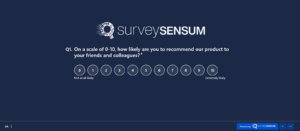
While implementing NPS surveys in a B2B SaaS business you must add product NPS questions. Adding this will enable you to identify detractors and passives that directly influence your product’s market perception. After that, analyze their feedback to boost user engagement and make the overall product experience better.
| When to Ask? | Who to Ask? | Why Ask? |
| Usually 30 or 90 days after customer onboarding And regularly after every 3 months |
Product Users | To gauge overall satisfaction, identify brand promoters and areas for improvement |
Your product NPS survey should ask these two questions:
One is a recommendation question:
- How likely are you to recommend our product to your friends and colleagues on a 0-10 point scale?
The second question you should ask is an open-ended question:
- What’s the one thing that you love the most about our product? [when customers score you 9 or 10]
- How can we serve you better? [when customers score you 7 or 8]
- What makes your experience dissatisfied? [when customers score 0-6]
Customize these questions to align with your specific B2B SaaS operations and customer engagement strategies.
Boost SaaS Customer Retention with NPS surveys!
2. Product Experience or Feature Launch Survey
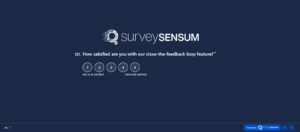
Product experience and feature launch surveys offer valuable insights into user preferences, satisfaction, and areas that require enhancement.
| When to Ask? | Who to Ask? | Why Ask? |
| After users engage with your product | Product Users | To understand satisfaction, identify pain points, and refine the product |
| After launching a new feature | Product Users | To gauge user response, find usability issues, and enhance the feature based on feedback |
In the product feature launch survey, you must ask the following questions:
- How satisfied are you with our close-the-feedback loop feature?
- How valuable is this feature for you?
- Would you like to recommend any feature to be included in the next update?
By asking these questions, you’ll understand how well your product features resonate with your customers. If your product isn’t working well, you can make small improvements right away.
3. Feature Prioritization Survey
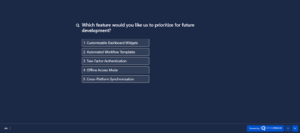
As the name suggests, feature prioritization surveys allow you to compare and contrast your product features and run a conjoint analysis to prioritize the development pipeline. To do that, pop a survey asking one question for 5-7 days. With these gathered insights, your product team can prioritize which feature to launch and start working on it.
| When to Ask? | Who to Ask? | Why Ask? |
| Before development starts | Product users | To gather ideas and perspectives from customers to let your product team align on priorities |
| Regularly – quarterly or bi-annually | Existing customers and potential users | To understand changing needs and preferences, and to keep your product competitive. |
In the feature prioritization surveys, you can customize and ask the following questions:
- Which feature should we focus on next?
- Better search
- Improved notifications
- Dark mode,
- Integrating with external calendars
4. Relationship NPS Survey
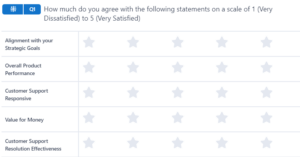
Launch a relationship NPS survey to measure how strong your relationship is with customers, and to identify paint point areas. These insights will help you grow your business and enhance customer relationships.
| When to Ask? | Who to Ask? | Why Ask? |
| Every 6 months | Product Users and decision-makers | To gauge overall satisfaction and the depth of customer relationships |
You must ask the following questions:
- On a scale of 0 to 10, how likely are you to recommend our service to your friends and colleagues on the basis of your experience?
- On a scale of 1 to 5, please rate the following aspects of our product or service, with 1 being very dissatisfied and 5 being very satisfied:
- Alignment with your strategic goals
- Customer support responsiveness
- Overall product performance
- Value for money
Note: Most companies do this survey once a year, which is not effective. By collecting feedback more frequently, you can implement necessary changes and gauge their impact more accurately. Also, conduct feedback after implementing changes to ensure that you can assess the effectiveness of those improvements.
Increase Customer Retention with Relationship NPS surveys
5. Onboarding Survey
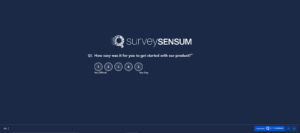
Embracing onboarding feedback surveys ensure a smooth start for your customers. These surveys gauge how well your onboarding process is functioning and pinpoint areas for potential improvement. With onboarding surveys, you lay the foundation for a successful B2B customer journey right from the very beginning.
| When to Ask? | Who to Ask? | Why Ask? |
| After new customers complete onboarding | Recently onboarded customers (New Customers) | To evaluate onboarding effectiveness, gather insights for enhancement |
In case of a quick onboarding, ask the following questions followed up by an open-ended question.
- How easy was the product onboarding process, on a scale of 1 to 5?
- Would you like to suggest something to improve the onboarding process?
But if the implementation took longer, such as 3, 6, or 9 months, ask the following questions.
- How would you rate the effectiveness of the implementation team?
- How responsive was the Customer Success team during this process?
The responses will help you ensure that they feel confident in their decision to choose you.
6. Subscription Cancellation Survey
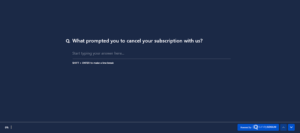
Implement subscription cancellation surveys to understand why customers choose to unsubscribe from your B2B SaaS service. These surveys offer valuable insights into the reasons behind cancellations, helping you address issues, and improve retention strategies.
| When to Ask? | Who to Ask? | Why Ask? |
| After customers cancel their subscription | Customers who have recently unsubscribed (Canceled Subscribers) | To uncover reasons for cancellations, identify pain points, and gather insights for improvement |
You must ask the following questions:
- What prompted your decision to cancel your subscription?
- Was there anything specific that you found unsatisfactory?
- What improvements could we make to our subscription service to better meet your needs?
By asking these questions, you can know the reason behind your churn customers and enhance future customer experiences.
7. Product Market Fit
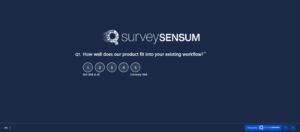
Use Product Market Fit surveys to ensure your B2B SaaS product aligns with the needs of your target market. These surveys gauge how well your product satisfies market demands and whether adjustments are necessary for optimal alignment.
| When to Ask? | Who to Ask? | Why Ask? |
| After customers have experienced your product | Product Users | To determine how well your product meets market needs, uncover potential gaps, and gather insights for refinement |
You can ask the following questions:
- To what extent does our product address your specific business requirements?
- How well does our product fit into your existing workflow?
Launch FREE Product Market Fit Surveys to Boost Customer Retention
STEP 3: How to Enhance Survey Response Rate?
Maximizing customer survey participation requires proactive measures. Here’s how to ensure optimal engagement:
- Strategically Send Surveys and Friendly Reminders: Send surveys to your customers. If they don’t respond at first, send them a few reminders. This well-thought-out approach boosts the response rate, encouraging active participation.
- Involve Account Managers: In case your customers still don’t respond, let your account managers step in. Customers often find it more comfortable to share insights through these channels. Account managers play a crucial role in eliciting invaluable feedback, contributing substantially to the depth of responses.
After all, without getting enough responses, how will you conduct a meaningful analysis?
STEP 4: Analyze the Feedback and Close the Loop
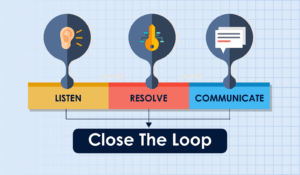
- Segregate Customers: Not all customers are the same. Some are more important than others. You might have key accounts (super important), regular customers, and so on. Sort them into groups.
- Find Detractors: Analyze the gathered feedback and find the customers who didn’t rate your service very well, especially in the key accounts group.
- Talk to Unhappy Customers: Reach out to the customers who rated your service low. Call them and ask them why they weren’t happy. This helps you understand their concerns better.
- Read Open-ended Feedback: Pay attention to what customers write in the open-ended feedback. Use Text Analytics Software to group these comments into themes or buckets like “bugs,” “price issues,” “feature requests,” and more.
- Go Deeper: Don’t stop there. Select a few unhappy customers from each group you created (like bugs or price issues). Talk to them in detail to gain a deeper understanding of their concerns.
- Prioritize which customers you need to talk to: If you receive 100 or more responses, avoid calling everyone. It’s not feasible! Instead, categorize NPS responses into key accounts. Focus on detractors and passives. Look for common themes from open-ended feedback. Then, match these themes with your key customers and get in touch with them. This way, you can address their concerns more effectively and improve their experience.
- Fix Problems: Now that you know what the problems are, create plans to fix them. Make a list of actions to take.
- Keep Customers Informed: Tell your account managers to keep the customers updated. Let them know when you’ve fixed the issues. Customers appreciate being kept in the loop.
Ensure from the CEO to frontline staff – everyone in your organization is ready to close the loop. This united approach can ensure prompt resolution of customer concerns, fostering loyalty and business growth.
9. Share Good News: Share these updates in newsletters or other communications. Let all your customers know the good things you’re doing to improve.
Note: It’s important to keep all your customers in the loop, especially the important ones, like key accounts or those facing common issues. This way, you make your business better by listening to what your customers have to say and taking action based on their feedback.
Now that we have established that retaining customers is good for business, let’s talk about how to measure customer retention?
4 Vital Metrics to Measure SaaS Customer Retention
In the B2B SaaS business, making sure customers are happy and stay engaged is important. But how can you really measure how well you’re doing?
Here are four key metrics that are like gold when it comes to understanding customer retention and driving your business forward:
Metric 1: Net Revenue Retention (NRR)
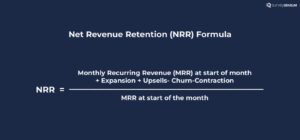
NRR assesses the net change in revenue from your existing customer base, considering both expansion (increased spending by customers) and contraction (reduced spending). It helps you understand if you’re generating more revenue from your current customers compared to the revenue lost due to churn.
A value greater than 100% indicates that your business is expanding its revenue from existing customers.
Metric 2: Gross Revenue Retention (GRR)
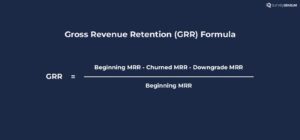
GRR specifically focuses on the revenue generated from your current customer base without accounting for any new customers you acquire during a certain period. It indicates how well you’re maintaining revenue streams from your existing customers.
This metric is particularly useful in gauging the effectiveness of your customer retention strategies and the loyalty of your customer base.
Metric 3: Growth Rate and Referral
Growth Rate reveal how quickly your SaaS business is expanding.
For instance, let’s take the example of Easebuzz, a payment solution company. They wanted to measure how quickly they were gaining new customers. To do this, they looked at the number of customers they had at the beginning of the year and compared it to the number they had at the end of the year. This calculation helped them understand their Growth Rate – the pace at which their customer base was growing.
Now, let’s talk about Referral.
Referral is like a bonus booster for your business’s growth. After Easebuzz improved its NPS score with SurveySensum, its customer satisfaction increased. Their NPS score jumped from 22 to 60, indicating that more customers were happy with their services.
They seized this opportunity and reached out to their satisfied customers aka promoters, and asked them to refer new customers to Easebuzz. These promoters, impressed by the improved services, gladly recommended them to others.
This led to an influx of new customers through word-of-mouth recommendations, enhancing Easebuzz’s customer base without the company having to actively seek out each new customer.
Metric 4: Usage Retention and Loss of Signal
Usage Retention evaluates how consistently your customers are using your software over time. Understanding this helps you identify patterns in customer behavior and discover the factors that contribute to long-term engagement.
Remarkably, this strategy can lead to retaining as much as 95-97% of your SaaS customers, as noted by Forbes ‘Why Churn May Be The Silent Killer Of Your SaaS’.
Conversely, Loss of Signal highlights instances where customers stop using your software. It signifies a potential issue that needs addressing like the customer encountered difficulties or found an alternative solution.
The average customer churn rate for SaaS businesses ranges between 3-5%, reinforcing the importance of this metric, as emphasized in, Forbes ‘Why Churn May Be The Silent Killer Of Your SaaS’.
By vigilantly monitoring this, you can proactively identify pain points and enhance your product to preemptively curtail customer churn.
Together, these metrics provide a full picture of your SaaS customer retention plans. More than just insights, they help you measure customer loyalty, drive revenue, measure satisfaction, and ensure your business’s overall health.
Remember, there are two important things to consider when measuring customer retention:
1. New Customer Churn vs. Mature Customer Churn
Customers who are new to your business can have higher churn rates compared to those who have been with you for a while. So, it’s a good idea to segregate your calculations based on how long your customers have been with you to get a clearer picture.
2. Reference Time
The time you pick for measuring and reporting customer retention really matters. Most businesses go with a calendar month – it’s like a middle-ground that helps you spot trends without making things too complicated. Going shorter can not show clear patterns, and going longer could make things harder to figure out. So, a month works just right.
By meticulously analyzing and acting upon these metrics, you can make informed decisions to enhance your customer retention strategies.
Increase Your SaaS Customer Retention With SurveySensum
Bringing in More Business with Customer Retention
By effectively implementing these B2B customer retention strategies, your business will bring more business by:
1.Enabling Advocacy
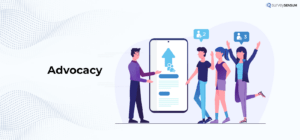
Your satisfied customers aka promoters have the potential to transform into influential advocates. How?
By sharing their positive experience and recommending your products and services to others to bring in new customers. By harnessing their authentic enthusiasm, you have the capacity to convert them into a potent marketing force, amplifying positive sentiments about your offerings and enticing new customers.
Here’s a strategic blueprint to facilitate this process:
- Recognition & Rewards: Acknowledge and reward promoters for their loyalty and positive feedback.
- Exclusive Offers: Provide special discounts and early access to new features as a token of appreciation.
- Engage Actively: Involve promoters in beta testing, feedback sessions, and product development discussions.
- Collaborations: Partner with promoters for joint content, webinars, and co-authored materials.
- Personalized Connection: Maintain personalized communication to nurture the relationship.
2.Increasing Word of Mouth and Referrals
When your customers find satisfaction in your offerings, they naturally become inclined to share their positive experiences with others. This word-of-mouth sharing holds immense potency due to the trust people place in recommendations from those they know. This organic endorsement serves as a compelling catalyst for the acquisition of new customers.
Illuminating this concept further, a study by Nielsen Consumer Trust Index unveiled that around 92% of consumers trust recommendations from family and friends.
So, to effectively harness this organic growth potential:
- Create referral programs that motivate your satisfied customers to refer others in exchange for incentives or rewards.
- Develop personalized outreach strategies for your loyal customers, inviting them to introduce your solutions to their network.
3.Focusing on the Key Accounts
NOT ALL B2B accounts are equal. Some bring in more value than others. To grow your business, you should strategically allocate the resources.
Here’s how you can make the most of it:
- Identify High-Value Accounts: As said, not all accounts are created equal. Only 20% of your accounts drive a substantial majority (80%) of your business revenue. By understanding this, you can prioritize these high-value accounts.
- Give Tailored Attention: If an account is on the brink of churning, recognizing its potential value can guide you to provide tailored support and interventions to retain it. These vital interactions not only prevent churn but also position these accounts as potential advocates.
- Build Advocate: High-value accounts have the potential to evolve into strong advocates. By exceeding their expectations, you can establish a positive relationship that transforms them into vocal supporters.
And here’s the interesting part: Harvard Business Review’s The Value of Keeping the Right Customers, reveals that by improving customer retention rates by just 5%, you could actually see your profits jump anywhere from 25% to a whopping 95%. That’s a pretty big impact from a small change!
When you’re dedicated to smart monetization strategies, you’re also nurturing your top clients. This creates a path of growth, lasting retention, and strong advocacy in the dynamic world of B2B SaaS.
4.Increasing Upselling
Happy customers are more likely to explore additional features or services that align with their needs. Use this opportunity to maximize revenue:
- Delve into customer data to identify those likely to benefit from premium features or advanced offerings.
- Design personalized upsell proposals that match individual usage patterns and requirements.
Concurrent with these strategies, an illuminating statistic from a report by Gartner research, Enable Growth in Existing Customers With the Gartner Cross-Sell and Upsell Blueprint emphasizes that businesses that effectively deploy personalization in upsell efforts can witness an impressive 10-30% increase in revenue.
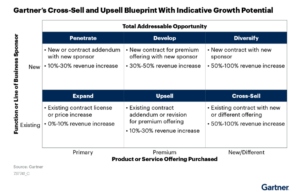
By embracing this, you not only harness the potential of upselling but also bolster customer engagement and foster a flourishing revenue.
5.Increasing Cross-Selling
Your current customers already know what your brand brings to the table. Why not introduce them to other solutions that can help with other challenges they might have? Here’s how:
- Find products or services that complement what they’re already using, making their overall experience even better.
- Share useful information that explains how these additional options can be beneficial.
Amid these strategies, a striking statistic from the Gartner research, Enable Growth in Existing Customers With the Gartner Cross-Sell and Upsell Blueprint resonates: Businesses implementing effective cross-selling techniques via existing contracts with new or different offers witness a notable 50-100% increase in revenue.
This reveals the remarkable potential of a well-crafted cross-selling approach. It’s not just about increasing your earnings; it’s about building a stronger connection with your customers. It’s like building a strong relationship that benefits both sides, resulting in a win-win situation.
With these strategies, you can definitely improve B2B SaaS customer retention. So, implement them and enhance your customer retention with SurveySensum.
Enhance Your SaaS Customer Retention with SurveySensum
Is your business tired of watching customers slip through your fingers like sand at the beach? If you’re nodding your head in agreement, then my friend, say hello to SurveySensum – your customer retention ally! It’s not just about plugging leaks; it functions as a revenue accelerator, seamlessly converting customers into advocates – just like Easebuzz did!
So, are you ready to see how our solution can transform your customer retention? Take the first step and book a demo with us. Your journey to enhance customer retention begins right here.






